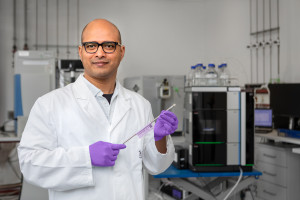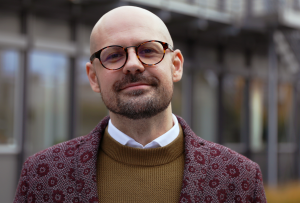Bochum/ Dortmund, 10th September 2024
"I haven't even arrived back in reality yet," says Marie (9) laughing as she stumbles slightly around the room. Until a few seconds ago, the primary school student was wearing virtual reality (VR) goggles and looking into a purely digital world. While she slowly finds her way around the classroom at Don Bosco primary school in Bochum, Kathrin Krieger helps the next student to immerse themselves in the virtual world. Together with Dr Jianxu Chen, head of the AMBIOM – Analysis of Microscopic BIOMedical Images research group at ISAS, the scientist visits class 3a in May.
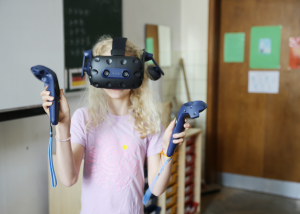
Marie explores a digital world with VR glasses. The controllers in her hands help her explore. This allows her to interact with the world and pick things up, for example.
© ISAS/ Clara Manthey
At ISAS in Dortmund, the two researchers are working on analysis methods for health research. More specifically, they are focusing on artificial intelligence (AI) for the evaluation and visualisation of microscopic images. Talking to primary school students about their work is a rare opportunity for them to transfer knowledge in a child-friendly way. The visit is also a new experience for the children. The topic of "extended reality" (XR, see info box) initially leaves many question marks on their faces. But Chen and Krieger have anticipated this and prepared intensively for the two-hour lesson with the class..
Only seven things at once
The children are listening attentively to Krieger who is standing in front of them at the whiteboard. The researcher starts at the very beginning: What is reality? What does extended reality mean? What can digital 3D models do that photos cannot? To answer these questions, the scientist has prepared a short memory test. The children are asked to memorise various symbols and later recognise which one is missing. They all agree when it comes to just three symbols: the laptop! But then it gets trickier, more and more pictures and symbols appear and the children find it increasingly difficult to recognise the missing object.
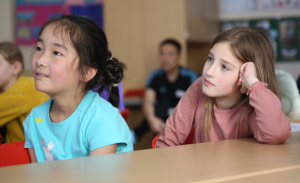
Lily and Charlotte are paying close attention to Krieger.
© ISAS / Clara Manthey
The test shows: Humans can only remember things to a limited extent. On average, the short-term memory can memorise seven things at once. With that, Krieger reveals a challenge for researchers in the microscopy laboratory to the children. A light sheet fluorescence microscope produces images of a single sample such as an entire organ (e.g. the jaw, knee or heart of a mouse) layer by layer - with an average of more than 500 images. Biologists later compile the individual images into a 3D model on the computer for analysis. This 3D model already helps the human brain to process the information from the many individual images in a focussed manner. However, with the help of XR goggles, these models can be used to literally grasp the examined organ and thereby analyse it even more precisely.
How do vision and information processing actually work? And how do humans perceive colours in the first place? In order to find the answers together, the 3a class continues with a transparent box full of colourful discs. Each child is allowed to choose a colour - a decision that is visibly difficult: blue, red or yellow? The students curiously grab the transparent colour discs and hold them in front of their eyes. The classroom suddenly appears in new colours. Some are thrilled to discover that they can create unexpected colours by combining discs.
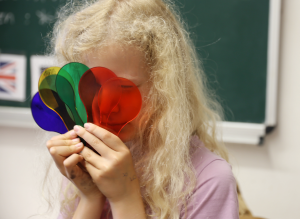
Marie chooses a transparent colour disc.
© ISAS / Clara Manthey
Extended reality
Extended reality (XR) is an umbrella term for immersive technologies that encompass virtual reality (VR), augmented reality (AR) and mixed reality (MR). The former creates a new, independent world for users. The VR world is a purely digital, computer-generated image that is completely independent of the physical environment. Instead of completely replacing the real world, AR visually overlays it with digital elements. These can be digital images, graphics or even animations. MR combines elements of VR and AR so that digital and real objects can interact with each other.
Virtual insight into the human body
Krieger rings a small bell and immediately all the children's eyes are on her again. The researcher uses the attention to show what she and Chen have brought with them: Apple Vision Pro and HTC Vive Pro 2 - AR and VR goggles (see info box), which all the children are allowed to try out. The researchers brought these XR goggles with them so that the third graders can experience for themselves what it feels like to be in virtual reality. The virtual space Krieger has chosen for today contains a model of a human body. She has developed the virtual environment at ISAS to better visualise 3D research results. Instead of other scientists, today the students can use controllers to grasp and reposition the individual organs. Some of the children are particularly engaged: "Johanna is taking the whole body apart," exclaims Finn (8) enthusiastically, looking at Krieger's laptop. The screen shows how Johanna is cheerfully removing all the organs from the body and distributing them in the virtual space.
Augmented reality – self-made today!
While the students wait to put on the XR goggles one by one, they make their own versions. Each child receives a pair of cardboard glasses onto which they can stick their own coloured tracing paper. Julian (8), who is still in the process of attaching the paper to his glasses, already has a clear idea: "I can't see anything special yet, I have to colour in both lenses first, then I'll see something nice. Those like Julian, who have listened carefully to Krieger's explanations at the beginning, are aware of this: Only if they paint an identical image on both lenses, they will be able to see something in the end. Just like in an AR world, they view their classroom as a real environment paired with their own artificially and artistically created elements. After just a short time, children are running around the classroom with their colourful glasses. Some have drawn figures on the tracing paper, others have created imaginative colourful worlds.
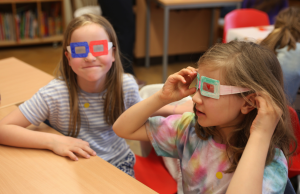
Anna and Greta with their self-painted cardboard glasses.
© ISAS / Clara Manthey
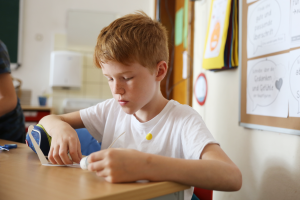
Julian draws the same picture on both lenses.
© ISAS / Clara Manthey
Knowledge transfer through hands-on experience
ISAS researchers like Chen and Krieger are keen to take part in activities like this. The two want to introduce the children to the topic of microscopy images in XR in a playful way. "Technologies like these are important tools. XR is ideal for children, as it combines theoretical knowledge transfer with hands-on experimentation," says Chen. The two researchers also benefit from the exchange: "To explain something to children, you have to focus on the most basic information. Dealing with my own research in this way and breaking it down to the essentials was an exciting process for me," summarises Krieger.
The MSCoreSys associated junior research group AMBIOM – Analysis of Microscopic BiOMedical Images is funded by the Federal Ministry of Education and Research (Bundesministerium für Bildung und Forschung, BMBF) under the funding reference 161L0272.
(Clara Manthey / Cheyenne Peters)







